SIGN UP FOR NEWSLETTER
Be the First to Know. Sign up to newsletter today
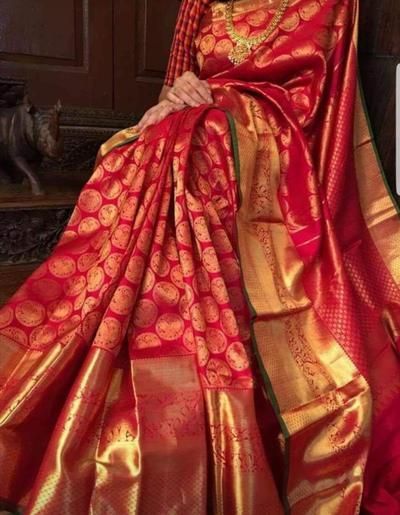
Kausy M
2411 views
add comment
We were shopping in the Santa cruz market in Mumbai for a family friend’s wedding. The salesgirl got us interested in Kanjivaram silk sarees by talking about the rich colours & textures. However, Kanjivaram sarees are expensive, each costing more than Rs. 50000/piece. Finally, we enquired about the origin of the sari. The sarees are woven in Kanchipuram near Chennai.
In addition, we wanted to buy sarees in bulk for several relatives for the wedding. This is a common tradition in several communities. Therefore, we decided to make a trip to Kanchipuram.
Kanchipuram is about 75 kms from Chennai. One can easily make a day trip as it takes approximately 2 hours to reach. There are several public transport buses that ply between Chennai and Kanchipuram. After that ,one can hire an auto in the town.
Kanchipuram, known for its famous Kanjivaram silk sarees or Kanchipuram silk sarees. The city is also known as the Varanasi of the South. As a matter of fact, Varanasi is the home of Banarsi sarees in North India.
In fact ,the city is one of the seven most sacred cities of India. It is also known as Sapta Puri and is located on the banks of the Vegavathy river. Above all, it is a pilgrimage site for both Shaivites and Vaishnavites, the two branches of Hinduism. (https://en.wikipedia.org/wiki/Kanchipuram). It has close to 100 temples. In other words, it was a religious center for both Buddhism & Jainism as well. The sanskrit language poet Kalidasa, described it as the city of cities—“Nagareshu Kanchi”.
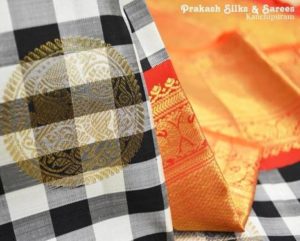
Two major weaving communities migrated from the neighbouring State of Andhra Pradesh to Kanchipuram in the State of Tamil Nadu. The King was a patron of Arts in the 16th century. He encouraged weaving. Interestingly, this was the beginning of handloom silk weaving in this temple town. Pure mulberry silk thread is used for weaving the silk saree. The silk is procured from the neighbouring State of Karnataka and the silver zari is procured from the State of Gujarat.
In a Kanjivaram silk saree, three shuttles are used. While the weaver works on the right side, his aide works on the left side . The border colors and designs are usually quite different from the body. If the pallu (the hanging end of the sari) has to be woven in a different shade, it is first separately woven. Subsequently, it is delicately joined to the saree. The part where the body meets the pallu is often denoted by a zig zag line.
The Kanjivaram silk (or Kanchipuram silk) is heavier than normal silk; it can be hand washed and lasts for several years. The heavier the saree, the better the quality. The Kanjiavarm silks sarees are expensive and authentic varieties are available only in select stores.
For instance, traditional colors are used in Kanjivaram sarees. for eg. Kili Pachai (parrot green), peacock blue and mango mustard are some of the popular colors. There are borders with distinct colors & designs in gold threads that are woven on to the sarees. The border styles have distinct names such as Temple borders, annapakshi (meaning birds) borders, butta borders and so on. Silver threads dipped in liquid gold are used on the borders. Authentic Kanjivaram silk sarees with gold zari borders are very expensive. As a matter of fact, pure gold zari is replaced by silver zari today.
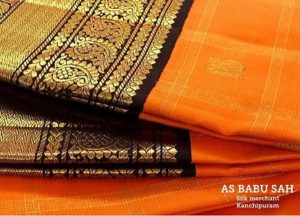
Pic credit : AS Babu Shah
Although Kanchipuram is well known for its Kanjivaram silk sarees, it is also home to the cotton weaving industry and cotton sarees.
Consequently, there are several shops for both cotton & silk sarees. We visited some of the following shops in Kanchipuram and picked some exquisitely beautiful sarees. The following shops are some of the well know and popular saree shops in Kanchipuram.
NS Santhanam
Rajamanikam stores
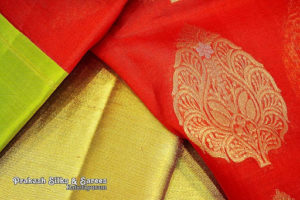
pic credit: Prakash Silk
We also manged a visit to the following Temples in Kanchipuram.
Historically, the city has a unique distinction of being ruled by almost all the major dynasties, prominent among them being the Pallavas, the Pandiyas, the Chalukyas and the Rashtrakutas.
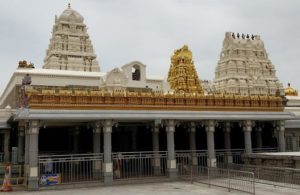
Pic credit :- Tamil Nadu Tourism.
This temple is located in the center of Kanchipuram. The Shakti Peethas (holy places of cosmic power) are places of worship consecrated to the goddess ‘Shakti’, the female principal of Hinduism. (WI)
The Goddess is seated in Padmasana (cross legged ,referred as a lotus pose ). She holds a sugarcane bow in her left upper arm, a lotus and parrot in her right upper arm. In her lower two arms she holds the divine chakras pasha (lasso), an ankusha (goad).
A moon like structure, called Chandraparai, is placed on her forehead.
In front of the deity, we can see the Sri Chakra installed by Adi Sankaracharya. Sri Yantra or Sri Chakra is a form of mystical diagram (yantra). It consists of nine interlocking triangles that surround a central point known as a bindu. These triangles represent the cosmos and human body.
Poojas(prayers) are first performed to SriChakra first and then to the deity.
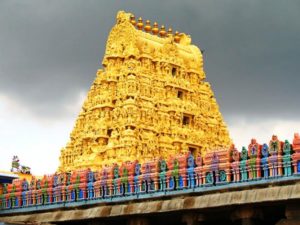
Pic credit :- Temple Advisor
It is significant to the Hindu sect of Shaivism as one of the temples associated with the five elements of nature- land, water, air, sky, fire., the Pancha Bhoota Stalas, and specifically to the element of earth, or Prithvi.
It is one of the largest temples with one of the largest gopurams ( towers) in India, standing 55 m tall. The present masonry structure was built during the Chola dynasty in the 9th century, while later expansions are attributed to Vijayanagar rulers.-WIKI
There is exquisite carving that can be found in the Temple. There are five sections that a devotee has to cross before he reaches the sanctum sanctorium. The hallway with a thousand pillars, which was built by the Vijayanagar kings, is found on the precinct after the gateway tower- WIKI
The presiding deity is Lord Shiva and the temple has been in existence even before 600 AD. Legend has it that Goddess Parvati, worshipped Lord Shiva under a mango tree for several years. The mango tree still exists in this temple. Each branch of the tree is said to bear a different variety of mango.
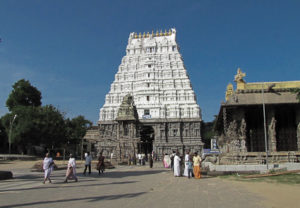
Pic credit :- Divine traveller
Varadharaja Perumal Temple or Hastagiri or Attiyuran is a Hindu temple dedicated to Lord Vishnu .It is one of the Divya Desams, the 108 temples of Vishnu believed to have been visited by the 12 poet saints, or Alwars. Further, it is located in a suburb of Kanchipuram. It is known as the Vishnu Kanchi, that is home to many famous Vishnu temples. Above all, One of the greatest Hindu scholars of Visishta Advaita philosophy, Ramanuja, is believed to have resided in this temple.-WIKI
This temple is dedicated to Lord Vishnu who granted a boon to Brahma. The temple was named Varadaraja (bestower of boon) Perumal temple. It is a large temple and has five courtyards, the deity of Lord Vishnu is in a standing posture.
The temple is also known for its golden lizards. Devotees climb a few steps to touch the golden lizard ,thereby removing any negative influence from their lives. There is a panel in the temple where the two lizards are depicted in the roof of the temple. WIIKI
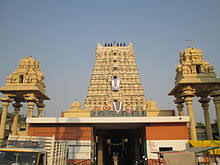
Pic credit :- Wikipedia
Also known as the Ooragathan temple is dedicated to Lord Vishnu. The deity is depicted as the Lord holding the right leg high representing the Vamana Avataar (the Lord’s incarnation as a dwarf) where he teaches a lesson to the demon king Bali.
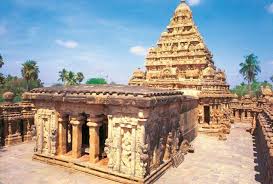
Pic credit :- pininterest
Further, the Kanchi Kailasanathar temple is the oldest structure in Kanchipuram. It is dedicated to the Lord Shiva, and is known for its historical importance.
As a matter of fact, the temple was built from 685-705 AD by a Rajasimha (Narasimhavarman II) ruler of the Pallava Dynasty. The low-slung sandstone compound contains a large number of carvings, including many half-animal deities which were popular during the early Dravidian architectural period. In addition, the structure contains 58 small shrines which are dedicated to various forms of Shiva. WIKI
However, this temple is known for its intricate carvings and the temple is under the care of Archaeological Survey of India. They are in fact, trying to restore the temple to its original glory. It is interesting to note that there is a tunnel in this temple which is supposed to represent the passage of life. The entry is narrow and the devotees have to crawl through it to the exit, which is also narrow, thus representing birth and death.
Contributed by Manjula
Read our other blog on sarees :-
Be the First to Know. Sign up to newsletter today
Good information. Lucky me I ran across your site by chance (stumbleupon).
I have book-marked it for later!